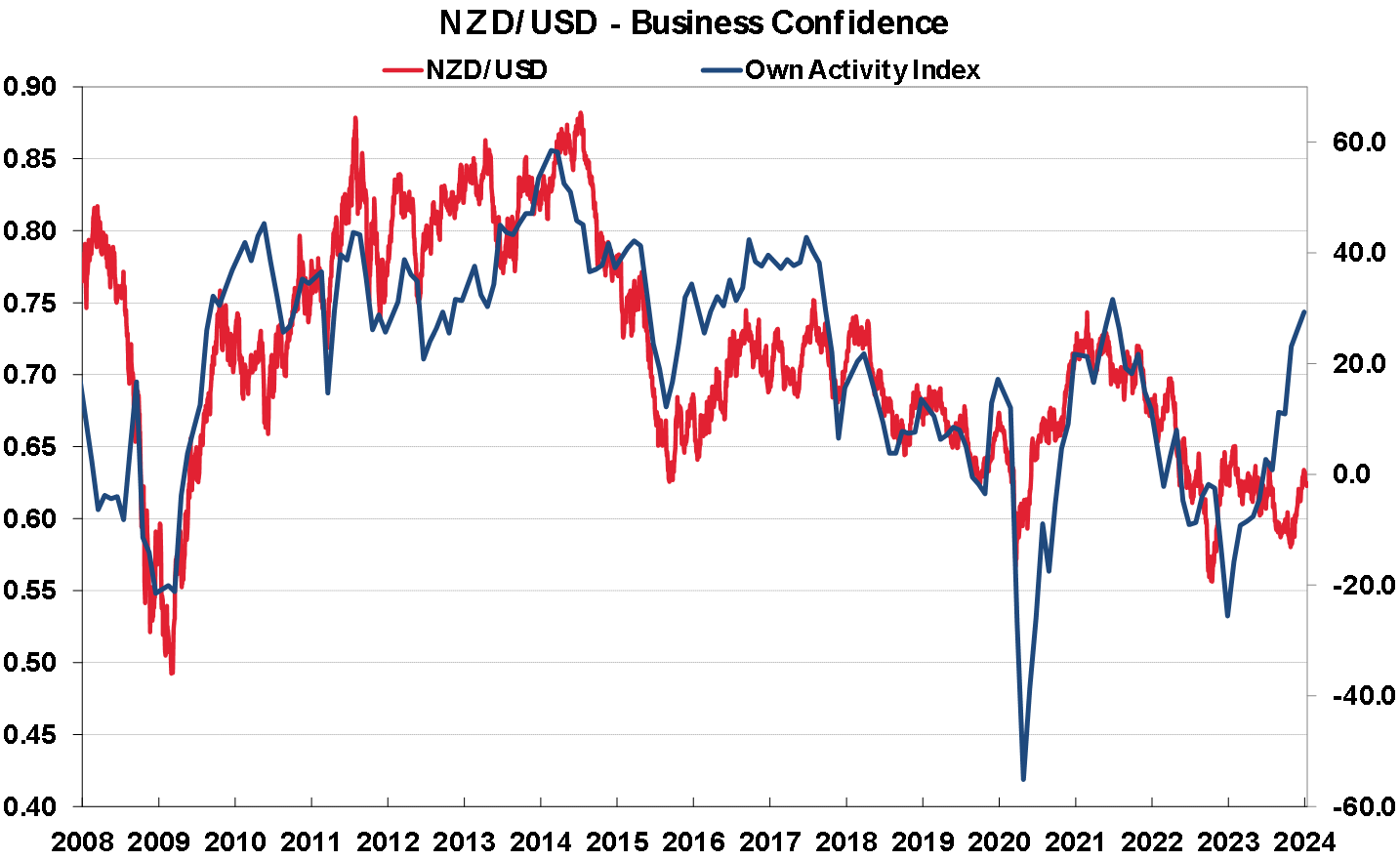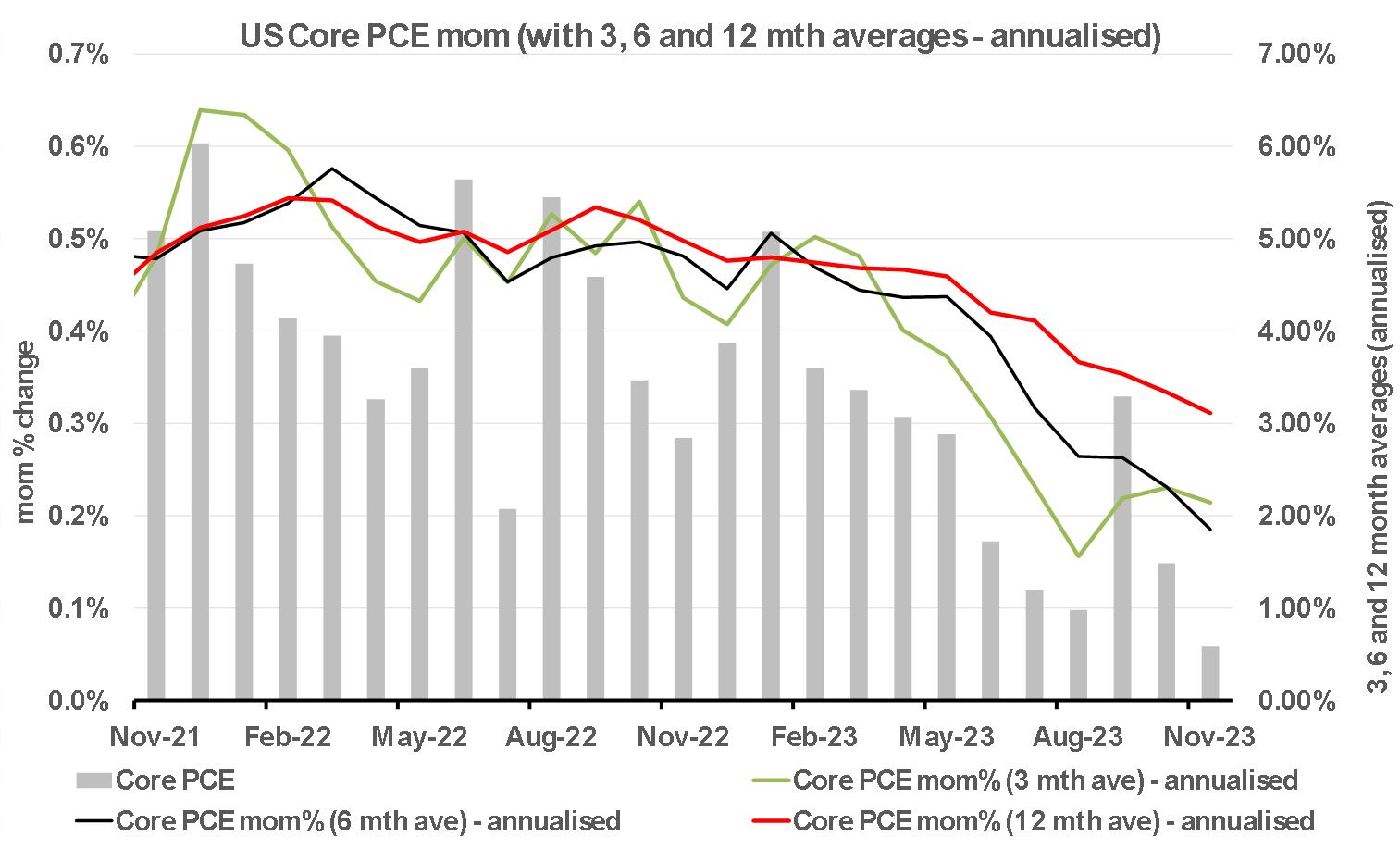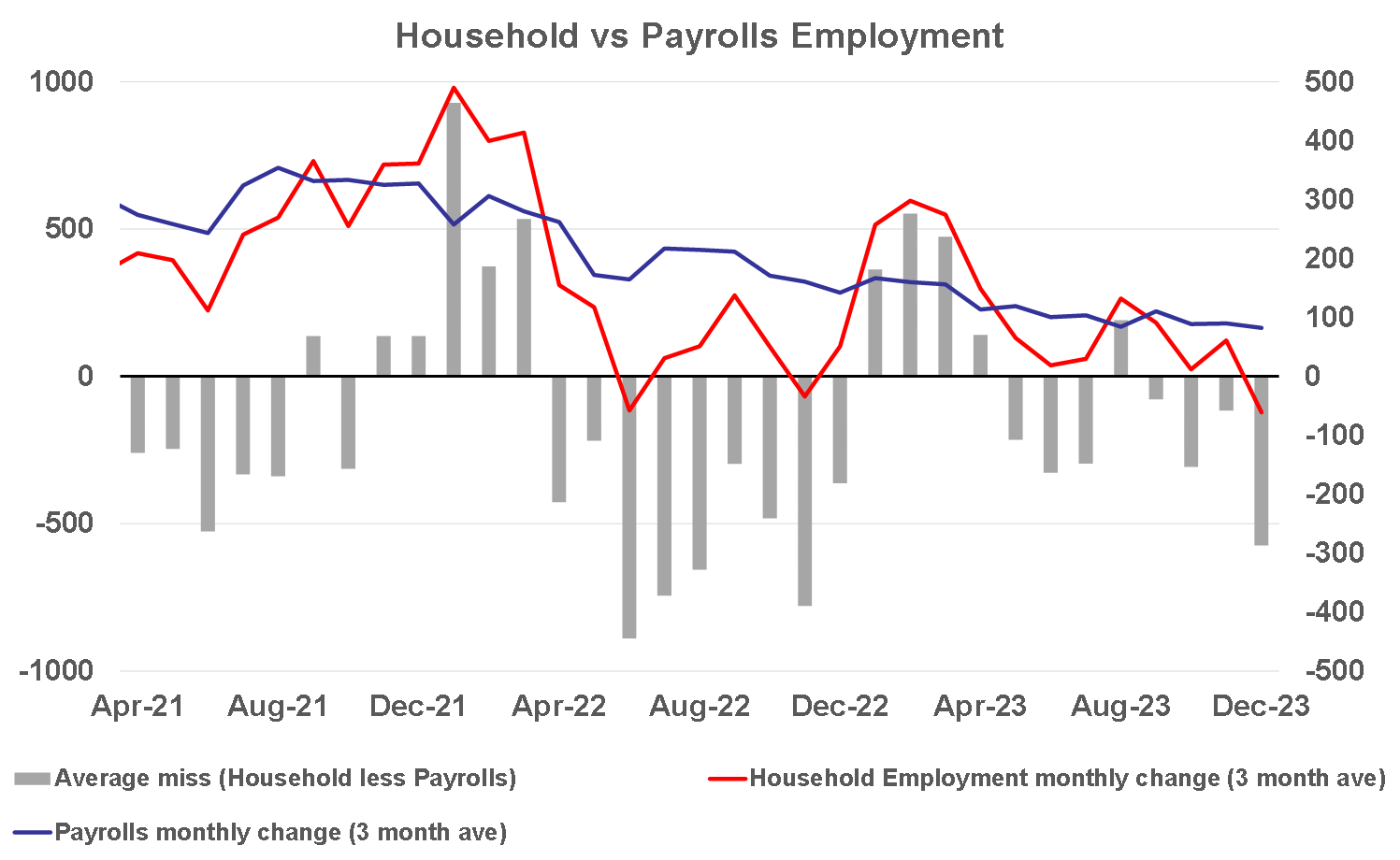
Summary of key points: -
- Australasian central banks will not be matching the Fed with rate cuts
- Standing back to look at underlying US inflation and employment trends
Australasian central banks will not be matching the Fed with rate cuts
The correction or pullback from the strong NZ dollar gains (due to heavy US dollar selling) witnessed over the second half of December has been the feature of currency markets over the first three weeks of January.
The 4.00% NZD/USD downwards correction from the high of 0.6350 to 0.6100 since 31 December has however been almost double the size of the 2.50% upwards USD correction on the Dixy Index from the low of 100.50 to 103.00 currently. There has been no fresh or negative New Zealand economic news to justify the Kiwi dollar depreciating much further than what general USD movements would suggest.
The answer to the NZ dollar under-performance lies with our trans-Tasman cousins, the Kiwi dollar closely tracks the Aussie dollar and weaker than expected inflation and jobs data in Australia has forced away any lingering expectations of further Reserve Bank of Australia (“RBA”) interest rate hikes. The New Years’ downwards correction in the AUD/USD exchange rate has been closer to three cents from a high of 0.6860 on 31 December to a low of 0.6550 last week. The AUD has already bounced back up to 0.6600, so at 0.6120 against the USD the Kiwi is lagging a little and is due for a catch-up back above 0.6200 in the short-term.
The outlook for the Aussie dollar in 2024 cannot be seen as one of high risk to depreciation from current levels. The positives for the AUD/USD remain with the RBA being considerably behind the eight-ball when it comes to containing and bringing down inflation. Electricity prices, rent and wages are all still increasing in Australia, therefore whilst the RBA may not raise their interest rates any further, they have absolutely no room to contemplate cutting rates. In this respect, the RBA are still the outlier and remain well behind other central banks with their timing. RBA Governor, Michelle Bullock is highly likely to remind the financial markets at the 6th February RBA meeting that they still have a long way to go in taming and controlling their inflation problem. The anticipated RBA pushback on lower interest rate market pricing will certainly be a positive for the Aussie dollar. How hawkish the RBA will be with the tone of their statement may well depend on the CPI inflation data for the December 2023 quarter being released on 31st January. Consensus forecasts are for a +0.80% increase for the quarter, reducing the annual inflation rate from 5.40% to 4.30%. An actual result above forecast will lift the Aussie dollar as the RBA will have to be more stringent in their stance/wording. The RBA’s own inflation forecast is a reduction to 4.50% in the annual rate.
Whilst the sudden Fed pivot on monetary policy in early December may have justified the rapid pricing-in of 1.50% of interest rate cuts in 2024 by the US markets, it is hard to reconcile why the local New Zealand interest rate markets would also quickly move to pricing-in 1.00% of cuts by the RBNZ in 2024. The New Zealand three to 10-year interest rates (swap market and Government bond market) are highly correlated to US term interest rates, so a reduction in the longer-dated yields is normal and expected. However, unlike the US, New Zealand has sticky, wage-push inflation that is not easy to pull back down. The market’s pricing of interest rate cuts in NZ this year may be one reason why the Kiwi dollar has under-performed over the last three weeks. The expectation of significant interest rate decreases in 2024 is not supported by our current or future inflation position. Local economists projecting RBNZ cuts by mid-year must be expecting a continuing and major contraction of the economy in 2024, but even that may not lower our inflation rate too much.
Guidance on NZ interest rate direction in 2024 will come from our December 2023 quarter inflation numbers on Wednesday 24th January. Prior forecasts for the quarterly increase range widely from 0.30% to 0.80%, lowering the annual inflation rate from 5.60% in the September quarter to somewhere between 4.50% and 4.90%. The RBNZ’s forecast is at the top-end of the range at +0.80%.
The local business media pundits became highly excited at the announcement that RBNZ Chief Economist, Paul Conway would be delivering a “on-the-record” and out of cycle speech on 30th January. Given that the last official RBNZ statement was 29th November, and the next review is 28th February, there is plenty of conjecture was to why the RBNZ are making a special speech during their excessive three-month summer hiatus. It is highly unlikely that Mr Conway will be giving any signal or message about their 2024 interest rate intentions in this speech, as it is entitled “Surfing the waves of economic change – changes to the global economy since the COVID-19 pandemic”. Looks like the speech will be a boring summary of what we already know, therefore not market moving.
One important NZ economic lead-indicator the RBNZ should be placing close attention to is business confidence. When asked about their “own activity” level for 2024, local business firms are much more optimistic today than at any time over the last six years. The Own Activity Index (what the outlook is for their own business) has been highly correlated to GDP growth for many years. Therefore, the doom and gloom merchants writing the NZ economy off in 2024 may be very wide of the actual mark. The Kiwi dollar is also highly correlated to the Own Activity Index as well, and it points to the NZD/USD exchange rate moving back up to above 0.7000. The year ahead does look reasonably tough for retail and house construction sectors due to high interest rates, however export, tourism and manufacturing sectors appear to be ready to invest and expand. An NZD/USD exchange rate above 0.7000, however, does totally rely on the US dollar itself depreciating significantly this year.

Standing back to look at underlying US inflation and employment trends
In analysing the information and forming a view on when and by how much US interest rates will decline in 2024 (accordingly how far the USD depreciates), it pays to stand back from the day-to-day data releases and market noise to examine and understand the underlying medium-term trends. Over the last three weeks, US employment, inflation and retail sales data for the month of December has all printed on the slightly stronger than expected side. Consequently, US 10-year bond yields have backed-up to 4.13% from 3.90% and the USD Dixy Index is up from below 101 to above 103. However, the better December data does not automatically mean that the first few months of 2024 are going to see a resurgence in the US economy.
Firstly, inflation trends in the Fed’s preferred PCE measure suggests that the 2.00% target has already been met with three- and six-month inflation results annualised already running at the 2.00% level. There is nothing on the horizon that points to any singly component part of US inflation being at risk to a sudden rise over coming months. The inexplicably lagged rents/shelter CPI component is still running above 6.00% per annum but will fall sharply over coming months. The Fed officials say they want to be sure that the lower inflation will stay down before cutting interest rates. Upcoming inflation numbers for January and February being released mid-February and mid-March should provide that assurance and cement-in up to 1.50% of US interest rate cuts this year.

Secondly, trends in US employment/labour market data is also painting a forward picture of weaker monthly numbers coming up in January, February and March. The December Non-Farm Payrolls result at a 216,000 increase in new jobs was above consensus forecasts, however prior months were again significantly revised downwards from the initial releases. Over the second half of 2023 all the jobs increase in the US economy where in the healthcare and government sectors. Those increases cannot continue at the same rate as all the post-COVID vacancies are now largely filled. Jobs in the retail, manufacturing, construction, energy and hospitality/leisure sectors have flattened off significantly.
The second measure of employment in the US (after Non-Farm Payrolls, which is a survey of businesses) is the Household Labour Force Survey. As the chart below depicts, the households survey three-month average has now dropped to below zero. The slower-moving Non-Farm Payrolls measure will continue to follow the household employment data lower over coming months.
The markets should not be surprised at +150,000 monthly payroll results instead of above 200,000. It all points to further decreases in US interest rates and the US dollar over the first half of 2024.

Daily exchange rates
Select chart tabs
*Roger J Kerr is Executive Chairman of Barrington Treasury Services NZ Limited. He has written commentaries on the NZ dollar since 1981.
2 Comments
I don’t think the ‘own intentions’ survey is anywhere near as strong as Roger says it is in terms of actual activity realised.
For example - while in residential construction there has, more often than not, been a strong relationship, probably 30% of the time there has been a poor or even inverse relationship. The period 2014-2015 demonstrates this, and no black swan event to explain it away.




We welcome your comments below. If you are not already registered, please register to comment.
Remember we welcome robust, respectful and insightful debate. We don't welcome abusive or defamatory comments and will de-register those repeatedly making such comments. Our current comment policy is here.